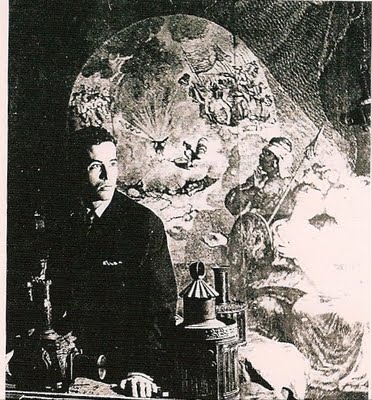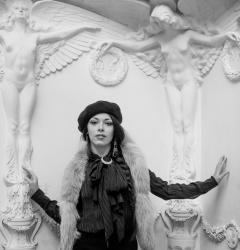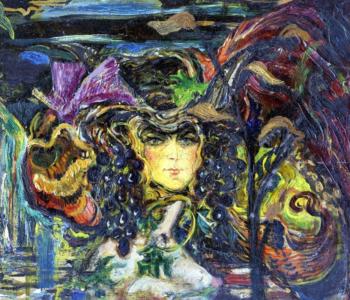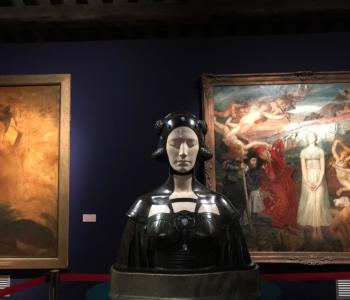
Kenneth Anger at the Cinematheque,Paris, 1950
“I’ve always considered movies evil;
the day that cinema was invented was a black day for mankind.”
Kenneth Anger
I started to see Kenneth Anger’s films after reading his book “Hollywood Babylon” but I didn’t expect to be so intrigued with him. A strange and controversial artist, who seems to be born for cinema, as his first appearance on the Hollywood scene was at the age of 8, in the role of the little Changeling Prince in the Warner’s Max Reinhardt film of A Midsummer Night’s Dream and, as a real enfant prodige, he made his first film at the age of 10. However, Anger showed early his dislike for making canonical films and began to work exclusively in short films without dialogue parts. This feature will become his distinction which, along the themes the films dealt with, will lead him to gain the reputation as one of the most influential independent filmmakers in cinema history.
Born in 1927 to a lower middle class family in Santa Monica, California, he developed an early interest in film, encouraged by his grandmother Bertha, who first took Kenneth to the cinema and she will influence his vision on cinema quite a lot. During adolescence he started to make his first works and he began to get interested in the occult, being very charmed by figures like Eliphas Levi, a french ceremonial magician, Sir James Frazer’s The Golden Bough and, his favorite, the English occultist Aleister Crowley. He became a great fan of Crowley’s work and later converted to Thelema. Meanwhile Anger discovered his homosexuality (still illegal in the United States) and started experimenting with the use of mind-altering drugs like cannabis and peyote. His name started to be popular in the underground gay scene and he also was arrested on obscenity charges for the short film Fireworks, in 1947. Between 1950 and 1960 Anger began to go back and forth Europe, visiting Paris, claimed by Jean Cocteau who admired his film “Fireworks” , Rome and Sicily where he travelled to the derelict Abbey of Thelema in Cefalù (used by Aleister Crowley for his commune during the 1920s) in order to film a short documentary entitled Thelema Abbey, now lost.
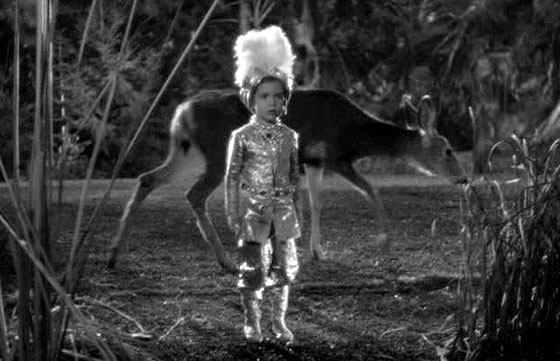
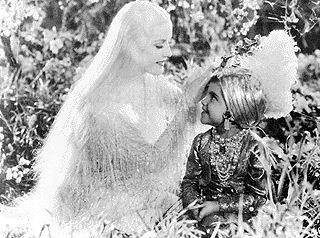 Kenneth Anger in A Midsummer Night’s Dream, 1935
Kenneth Anger in A Midsummer Night’s Dream, 1935
It has to be said that only a little part of Anger’s works survived until today, al lot of wonderful and rare works had been lost or destroyed. Since 1937, when he made his first film, he has produced almost forty works, nine of which have been grouped together as the “Magick Lantern Cycle”. This cycle includes all the works survived until “Lucifer Rising”, his most famous film. I think that Magick Lantern is not only the name of this cycle, but it also defines the idea Anger has about cinema. It’s like a magic power, as his official site points out, “Anger is a high level practitioner of occult magic who regards the projection of his films as ceremonies capable of invoking spiritual forces. Cinema, he claims, is an evil force. Its point is to exert control over people and events and his filmmaking is carried out with precisely that intention.”
Cinema is like a magic lantern from which strange and wordless images are projected. Without using languages, Anger’s films become universal and pure images speak for themself. In some way he arrested cinema to the silent era, abanding sound and preferring short films. Cinema is located in the dreaming dimension (Fireworks) or in a trance (Pleasure Dome, Lucifer Rising), the oniric dimension is most likley to be attributed to surrealist influence (Buñuel, Cocteau) but Anger cinema is also highly symbolical. “He sublimates in gods, forces and demons element of contemporary pop culture (Puce Moment, Scorpio Rising, Kustom Kar Kommandos, also Inauguration of the Pleasure Dome). This view of pop culture as vehicle for ancient archetypes is also the basis of Hollywood Babylon, his famous book about the seedier aspects of Hollywood history.”
1. Fireworks, 1947
“In Fireworks, I released all the explosive pyrotechnics of a dream. Inflammable desires dampened by day under the cold water of consciousness are ignited that night by the libertarian matches of sleep, and burst forth in showers of shimmering incandescence. These imaginary displays provide a temporary relief.”
“A dissatisfied dreamer awakes, goes out in the night seeking a ‘light’ and is drawn through the needle’s eye. A dream of a dream, he returns to a bed less empty than before. This flick is all I have to say about being 17, the United States Navy, American Christmas and the fourth of July.”
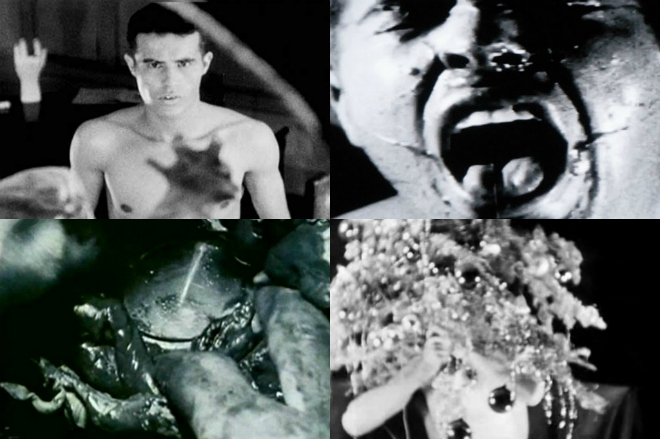

2. Puce Moment, 1949
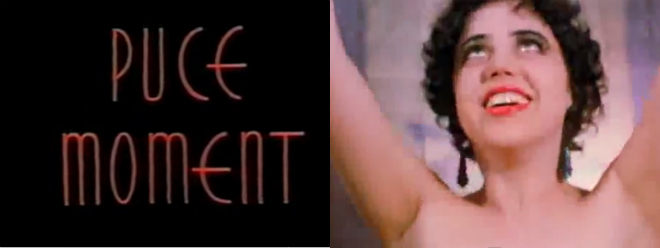
original video here
It’s a 6 minutes video from a unfinished work on a film called Puce Women. Anger said “Puce Women was my love affair with Hollywood… with all the great goddesses of the silent screen. They were to be filmed in their homes; I was, in effect, filming ghosts.” The film begins with a view of 1920s style flapper gowns being taken off a dress rack and flying toward the screen. A glamourous actress, played by Yvonne Marquis, dresses in the sparkling puce gown before going out for a walk with her dogs. The dresses belonged to Anger’s grandmother.

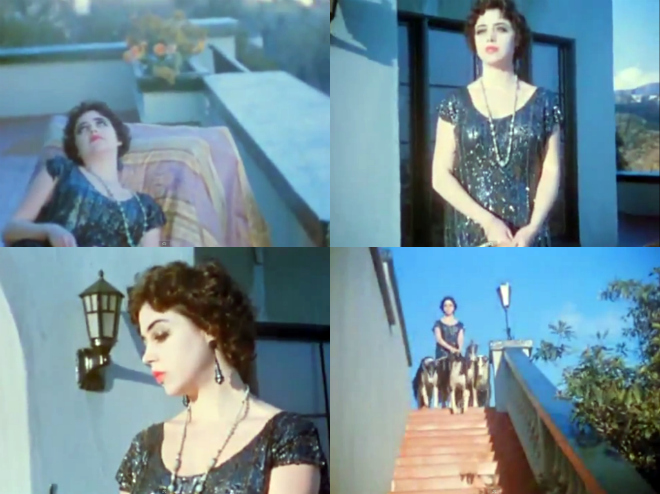
3. Rabbit’s Moon, 1950

original video here
A sad story of an unanswered love and an impossible longing, one of my favorite. It reminds me Alla Nazimova’s Salomé for the moon struggling and the final death. Bill Landis said “Anger used a rich pancultural texture of myth to explain his own psychological condition in Rabbit’s Moon. The rabbit in the moon is lifted out of Japanese myth, with the moon in Crowleyan terms representing the female principal. The character Pierrot was based on Crowley’s tarot card of the Fool, which meant divine inspiration in spiritual or creative matters, but folly, mania, or death in everyday affairs. The highly stylized mime movements of the actors, which was part of early 20th century avant-garde theatre, recalls both Kabuki and commedia dell’arte, where Columbine emotionally tortures Pierrot with Harlequin’s assistance. The set itself resembles the art deco forest of silver trees in A Midsummer Night’s Dream.”
The film tells the story of a lonely clown named Pierrot who pines for the moon, and reaches for it – for inside lies a white rabbit. Pierrot tries and tries again, romantically reaching for the stars, but always falls to the floor of the blue forest which he inhabits. Another clown suddenly appears, an exuberant force who wears a darker costume: his name is Harlequin. Harlequin seemingly threatens Pierrot, but he soon reveals the sight of a beautiful woman named Columbine. Pierrot immediately falls for her, but he fails to win her heart. Poor Pierrot, heartbroken, is then shown the entrance to a mysterious realm, supposedly on the moon, where he finds the rabbit, and Columbine and Harlequin dancing in perfect motion. To the sound of The El Dorado’s (Tears On My Pillow) Pierrot throws himself from the moon, resulting in his death as he crash lands back onto the harsh land of the forest.


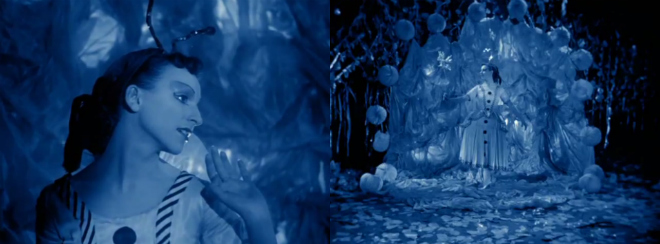
4. Eaux d’artifice, 1953
The most oneiric of all his works and my favorite at all, shooted at Villa D’Este, near Rome, when he planned to make a film about the sixteenth century Cardinal Ippolito II d’Este. This was supposedly going to be only the first of four scenes, but the others were not made. While Vivaldi’s The Four Seasons plays, a Baroque lady flits in and out of Villa d’Este’s fountain until she melts into the waters. Anger said “Hide and seek in a night-time labyrinth of levels, cascades, balusrades, grottoes, and ever-gushing leaping fountains, until the water witch and the fountain become one.” The film was shot in black & white and printed through a blue filter and the Lady’s “Fan of Exorcism” was hand-tinted by Anger.



5. Inauguration of the pleasure dome, 1954-56

The title of the film comes from the poem “Kublai Khan” by the English Romantic poet Samuel Taylor Coleridge who claimed that the poem came to him during an opium dream. The poem tells the story of the Mongol general and statesman who built a pleasure dome. The film, subtitled “Lord Shiva’s Dream”, was inspired by a costume party based upon the theme of “Come As Your Madness” and featured many Crowleyan and Thelemite themes, with many of the various characters personifying various pagan gods such as Isis, Osiris and Pan. One of the actresses in the film was Marjorie Cameron, the widow of Jack Parsons, the influential American Thelemite who had died a few years previously, while Anger himself played Hecate and erotica author and diarist Anaïs Nin played Astarte.
Anger said about this film: “a convocation of magicians assume the identity of gods in a Dionysian revel. Lord Shiva, the magician, awakes. The Scarlet Woman, whore of heaven, smokes a big, fat joint; Astarte of the moon brings the wing of snow; Pan bestows the grapes of Bacchus; Hecate offers the sacred mushroom, yage, wormwood brew… The orgy ensues – a magick masquerade at which Pan is the prize. Lady Kali blesses the rites of the children of light as Lord Shiva invokes the godhead with the formula Force and Fire.”
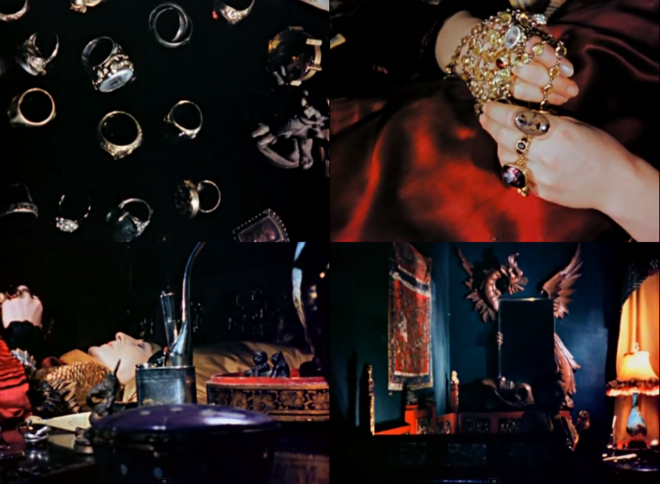


6. Scorpio Rising, 1963
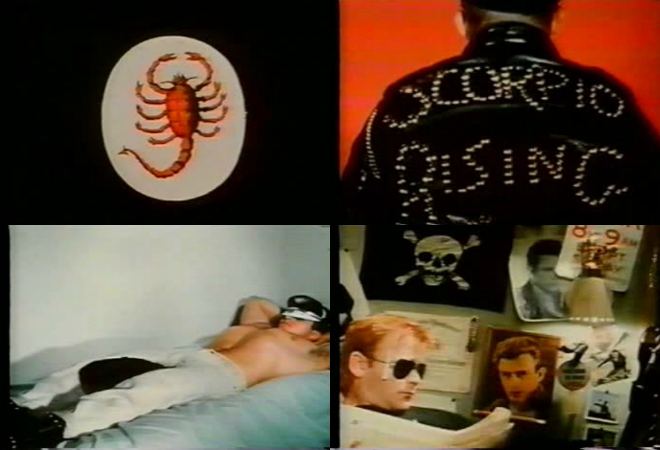
As Anger himself described it: “A death mirror held up to American culture. Brando, bikes, black leather. Christ, chains and cocaine. A ‘high’ view of the myth of the American motorcyclist. The machine as totem from toy to terror. Thanatos in chrome and black leather and bursting jeans.”
Scorpio Rising is a translation of Inauguration of the Pleasure Dome. The fetish objects are now the paraphernalia of youth subculture and the violence more savage and overt. But the patterns are the same, a loving preparation for the ritual, the build up of energy at the ritual and finally the act of destruction. Anger has simply taken his show to the street.
Scorpio, a leather-wearing, crystal methamphetamine-snorting bad boy is seen strutting his stuff, racing his bike, vandalizing a church and attending a rowdy party where a fellow reveler is tortured and humiliated by the bikers. Through it all, Anger draws clear parallels between Scorpio’s crowd, sadism and homosexuality, with alternately subtle and obvious montages depicting snippets of other films, comic strips, plenty of gleaming phallic chrome, symbols like the Nazi swastika and clips of the life of Jesus Christ taken from Family Films’ The Road to Jerusalem. That this machine-fixated biker gang is a death cult is made obvious by the omnipresence of the skull and cross bones, the adoption of Nazi imagery and the noose that hangs in the hero’s bedroom. At the end of the film there is an accident that leaves one of the bikers, presumably the hero, dead.


7. Kustom Kar Kommandos, 1964
It was originally to be an eight part, 30 minute film, which Anger described as an “erotic vision of a contemporary American (and specifically Californian) teenage phenomenon, the world of hot-rod and customized cars.” Because of lacking of funds he was unable to finish the film.

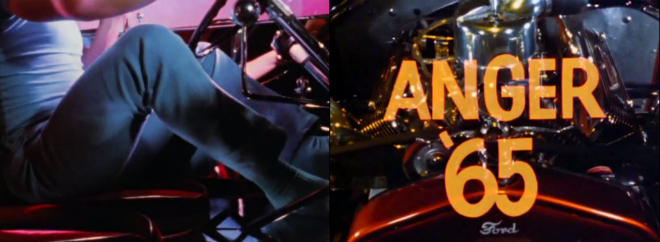
8. Invocation of my demon brother, 1969
a very interesting version commented by Anger himself
According to Anger own words: “a conjuration of pagan forces come off the screen in a surge of spiritual and mystical power. Shadowing forth of Lord Lucifer, as the powers gather at a midnight mass.” This footage it’s what left of the original “Lucifer Rising”, stolen in 1967.


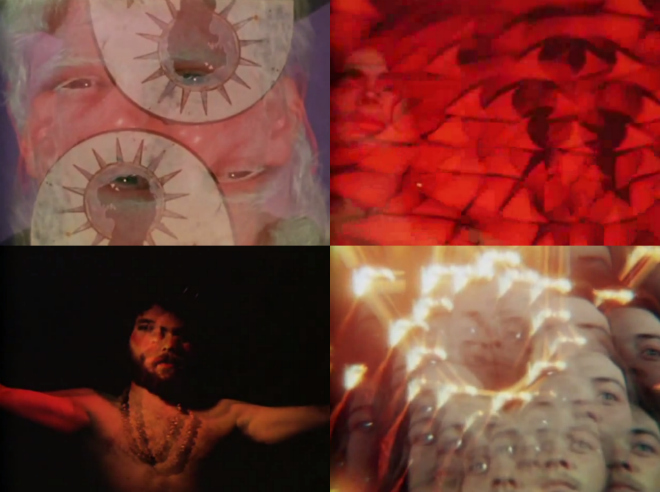

9. Lucifer Rising, 1970-80
The film, said Anger, “is about the love generation, the birthday party of the Aquarian Age showing actual ceremonies to make Lucifer rise. Lucifer is the Light god, not the devil, the Rebel Angel behind what’s happening in the world today. His message is that the key of joy is disobedience. Isis (Nature) wakes. Osiris (Death) answers. Lilith (Destroyer) climbs to the place of Sacrifice. The Magus activates the circle and Lucifer – Bringer of Light – breaks through.”
Perhaps Anger’s most elaborate film, Lucifer Rising takes place at various historically magick spots in Egypt, England and Germany. The odd rock-tinged soundtrack (composed and recorded by Beausoleil in prison) pulls viewers through a series of obsessively staged and hauntingly realized ceremonies, movements and rituals. Based upon the Thelemite concept that mankind had entered a new period known as the Aeon of Horus, “Lucifer Rising” was full of occult symbolism, starring Miriam Gibril as the Ancient Egyptian goddess Isis and Donald Cammell as her consort Osiris, as well as Marianne Faithfull as the Biblical figure of Lilith and Leslie Huggins as Lucifer himself (after Mick Jagger refused the part). Anger once again appeared in the film, starring as the Magus, the same role that he played in Invocation to My Demon Brother.






Missoni fall 2010 campaign movie
This is the last Anger’s work. Althought is an advertising and from a controversial filmmaker like Anger it would be a little commercial, I think that he was able to stay true to his ideals. This is one of the rare cases when an artist express himself not being enslaved by the client.
sources: www.kennethanger.org; subcin.com; e-filmblog.blogspot.com; alfredsplace.com; scans and collages by me.

